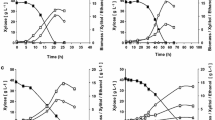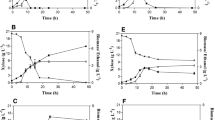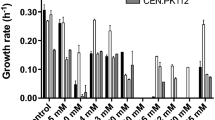Abstract
The microbial conversion of pentoses to ethanol is one of the major drawbacks that limits the complete use of lignocellulosic sugars. In this study, we compared the yeast species Spathaspora arborariae, Spathaspora passalidarum, and Sheffersomyces stipitis regarding their potential use for xylose fermentation. Herein, we evaluated the effects of xylose concentration, presence of glucose, and temperature on ethanol production. The inhibitory effects of furfural, hydroxymethylfurfural (HMF), acetic acid, and ethanol were also determined. The highest ethanol yield (0.44 g/g) and productivity (1.02 g/L.h) were obtained using Sp. passalidarum grown in 100 g/L xylose at 32 °C. The rate of xylose consumption was reduced in the presence of glucose for the species tested. Hydroxymethylfurfural did not inhibit the growth of yeasts, whereas furfural extended their lag phase. Acetic acid inhibited the growth and fermentation of all yeasts. Furthermore, we showed that these xylose-fermenting yeasts do not produce ethanol concentrations greater than 4% (v/v), probably due to the inhibitory effects of ethanol on yeast physiology. Our data confirm that among the studied yeasts, Sp. passalidarum is the most promising for xylose fermentation, and the low tolerance to ethanol is an important aspect to be improved to increase its performance for second-generation (2G) ethanol production. Our molecular data showed that this yeast failed to induce the expression of some classical genes involved in ethanol tolerance. These findings suggest that Sp. passalidarum may have not activated a proper response to the stress, impacting its ability to overcome the negative effects of ethanol on the cells.






Similar content being viewed by others
Availability of data and material
Not applicable.
Code availability
Not applicable.
References
Sun Y, Cheng J (2002) Hydrolysis of lignocellulosic materials for ethanol production: a review. Bioresour Technol 83:1–11. https://doi.org/10.1016/S0960-8524(01)00212-7
Soccol CR, Vandenberghe LPDS, Medeiros ABP et al (2010) Bioethanol from lignocelluloses: Status and perspectives in Brazil. Bioresour Technol 101(13):4820–4825. https://doi.org/10.1016/j.biortech.2009.11.067
Limayem A, Ricke SC (2012) Lignocellulosic biomass for bioethanol production: Current perspectives, potential issues and future prospects. Prog Energy Combust Sci 38(4):449–467. https://doi.org/10.1016/j.pecs.2012.03.002
Canilha L, Chandel AK, Suzane Dos Santos Milessi T et al (2012) Bioconversion of sugarcane biomass into ethanol: An overview about composition, pretreatment methods, detoxification of hydrolysates, enzymatic saccharification, and ethanol fermentation. J Biomed Biotechnol 1-15.https://doi.org/10.1155/2012/989572
da Cunha-Pereira F, Hickert LR, Sehnem NT et al (2011) Conversion of sugars present in rice hull hydrolysates into ethanol by Spathaspora arborariae, Saccharomyces cerevisiae, and their co-fermentations. Bioresour Technol 102(5):4218–4225. https://doi.org/10.1016/j.biortech.2010.12.060
Cadete RM, Rosa CA (2017) The yeasts of the genus Spathaspora: potential candidates for second-generation biofuel production. Yeast Primer 35(2):191–199. https://doi.org/10.1002/yea.3279
Kuyper M, Hartog MMP, Toirkens MJ et al (2005) Metabolic engineering of a xylose-isomerase-expressing Saccharomyces cerevisiae strain for rapid anaerobic xylose fermentation. FEMS Yeast Res 5:399–409. https://doi.org/10.1016/j.femsyr.2004.09.010
Nevoigt E (2008) Progress in metabolic engineering of Saccharomyces cerevisiae. Microbiol Mol Biol Rev 72(3):379–412. https://doi.org/10.1128/MMBR.00025-07
Salusjärvi L, Kankainen M, Soliymani R et al (2008) Regulation of xylose metabolism in recombinant Saccharomyces cerevisiae. Microb Cell Fact 16:1–16. https://doi.org/10.1186/1475-2859-7-18
Sharma S, Arora A (2020) Tracking strategic developments for conferring xylose utilization/fermentation by Saccharomyces cerevisiae. Ann Microbiol 70(50):1–17. https://doi.org/10.1186/s13213-020-01590-9
Agbogbo FK, Coward-Kelly G, Torry-Smith M, Wenger KS (2006) Fermentation of glucose/xylose mixtures using Pichia stipitis. Process Biochem 41(11):2333–2336. https://doi.org/10.1016/j.procbio.2006.05.004
Hickert LR, De S-C, Rosa CA, Ayub MAS (2013) Simultaneous saccharification and co-fermentation of un-detoxified rice hull hydrolysate by Saccharomyces cerevisiae ICV D254 and Spathaspora arborariae NRRL Y-48658 for the production of ethanol and xylitol. Bioresour Technol 143:112–116. https://doi.org/10.1016/j.biortech.2013.05.123
Cadete RM, Santos RO, Melo MA et al (2009) Spathaspora arborariae sp. nov., a D-xylose-fermenting yeast species isolated from rotting wood in Brazil. FEMS Yeast Res 9(8):1338–1342. https://doi.org/10.1111/j.1567-1364.2009.00582.x
Veras HCT, Parachin NS, Almeida JRM (2017) Comparative assessment of fermentative capacity of different xylose-consuming yeasts. Microb Cell Fact 16(153):1–8. https://doi.org/10.1186/s12934-017-0766-x
Lachke A (2002) Biofuel from D-xylose – The second most abundant sugar. Reson 7(5):50–58. https://doi.org/10.1007/BF02836736
Hou X (2012) Anaerobic xylose fermentation by Spathaspora passalidarum. Appl Microbiol Biotechnol 94(1):205–214. https://doi.org/10.1007/s00253-011-3694-4
Pignal M-C (1967) Une nouvelle espece de levure isole e de larves d’insectes: Pichia stipitis. Bull Mens Soc Linn Lyon 36:163–168. https://doi.org/10.3406/linly.1967.5915
Nguyen NH, Suh SO, Marshall CJ, Blackwell M (2006) Morphological and ecological similarities: wood-boring beetles associated with novel xylose-fermenting yeasts, Spathaspora passalidarum gen. sp. nov. and Candida jeffriesii sp. nov. Mycol Res 110(10):1232–1241. https://doi.org/10.1016/j.mycres.2006.07.002
Hou X, Yao S (2012) Improved inhibitor tolerance in xylose-fermenting yeast Spathaspora passalidarum by mutagenesis and protoplast fusion. Appl Microbiol Biotechnol 93(6):2591–2601. https://doi.org/10.1007/s00253-011-3693-5
Deparis Q, Claes A, Foulquié-Moreno MR, Thevelein JM (2017) Engineering tolerance to industrially relevant stress factors in yeast cell factories. FEMS Yeast Res 17(4):1–17. https://doi.org/10.1093/femsyr/fox036
de Souza CJA, Costa DA, Rodrigues MQRB et al (2012) The influence of pre saccharification, fermentation temperature and yeast strain on ethanol production from sugarcane bagasse. Bioresour Technol 109:63–69. https://doi.org/10.1016/j.biortech.2012.01.024
Ye J, Coulouris G, Zaretskaya I, Cutcutache I et al (2012) Primer-BLAST: A tool to design target-specific primers for polymerase chain reaction. BMC Bioinformatic 13(134):1–11. https://doi.org/10.1186/1471-2105-13-134
Untergasser A, Nijveen H, Rao X, Bisseling T (2007) Primer3Plus, an enhanced web interface to Primer3. Nucleic Acids Res 35:71–74. https://doi.org/10.1093/nar/gkm306
Cadete RM, de las Heras AM, Sandström AG et al (2016) Exploring xylose metabolism in Spathaspora species: XYL1.2 from Spathaspora passalidarum as the key for efficient anaerobic xylose fermentation in metabolic engineered Saccharomyces cerevisiae. Biotechnol Biofuels 9(167):1–14. https://doi.org/10.1186/s13068-016-0570-6
Caspeta L, Castillo T, Nielsen J (2015) Modifying yeast tolerance to inhibitory conditions of ethanol production processes. Front Bioeng Biotechnol 3:1–15. https://doi.org/10.3389/fbioe.2015.00184
Ma M, Liu LZ (2010) Quantitative transcription dynamic analysis reveals candidate genes and key regulators for ethanol tolerance in Saccharomyces cerevisiae. BMC Microbiol 10(169):1–20. https://doi.org/10.1186/1471-2180-10-169
Nakanishi SC, Soares LB, Biazi LE et al (2017) Fermentation strategy for second generation ethanol production from sugarcane bagasse hydrolyzate by Spathaspora passalidarum and Scheffersomyces stipitis. Biotechnol Bioeng 114(10):2211–2221. https://doi.org/10.1002/bit.26357
Kim SR, Park YC, Jin YS, Seo JH (2013) Strain engineering of Saccharomyces cerevisiae for enhanced xylose metabolism. Biotechnol Adv 31:851–861. https://doi.org/10.1016/j.biotechadv.2013.03.004
Cadete RM, Melo MA, Dussán KJ et al (2012) Diversity and Physiological Characterization of D-Xylose- Fermenting Yeasts Isolated from the Brazilian Amazonian Forest. PLoS One 7(8):e43135. https://doi.org/10.1371/journal.pone.0043135
de Albuquerque TL, da Silva IJ, de Macedo GR, Rocha MPV (2014) Biotechnological production of xylitol from lignocellulosic wastes: A review. Process Biochem 49(11):1779–1789. https://doi.org/10.1016/j.procbio.2014.07.010
Lugani Y, Puri M, Singh B (2021) Recent insights, applications and prospects of xylose reductase: a futuristic enzyme for xylitol production. Eur Food Res Technol 247(4):921–946. https://doi.org/10.1007/s00217-020-03674-x
Harner NK, Wen X, Bajwa PK et al (2015) Genetic improvement of native xylose-fermenting yeasts for ethanol production. J Ind Microbiol Biotechnol 42(1):1–20. https://doi.org/10.1007/s10295-014-1535-z
Conrad M, Schothorst J, Kankipati HN et al (2014) Nutrient sensing and signaling in the yeast Saccharomyces cerevisiae. FEMS Microbiol Rev 38:254–299. https://doi.org/10.1111/1574-6976.12065
Ribeiro LE, Albuini FM, Castro AG et al (2021) Influence of glucose on xylose metabolization by Spathaspora passalidarum. Fungal Genet Biol 157:103624. https://doi.org/10.1016/j.fgb.2021.103624
Liu ZL, Slininger PJ, Gorsich SW (2005) Enhanced biotransformation of furfural and hydroxymethylfurfural by newly developed ethanologenic yeast strains. Appl Biochem Biotechnol 121:451–460. https://doi.org/10.1385/ABAB:121:1-3:0451
Tanaka K, Koyama M, Thi P et al (2019) Production of high-concentration bioethanol from cassava stem by repeated hydrolysis and intermittent yeast inoculation. Int Biodeterior Biodegrad 138:1–7. https://doi.org/10.1016/j.ibiod.2018.12.007
Pham P, Tuyet-Le D, ThuHuong L et al (2019) Recycling cassava stem to bioethanol by inoculating a novel xylose – glucose fermenting yeast at high initial concentration. Environ Prog Sustain Energy 39(1):e13286. https://doi.org/10.1002/ep.13286
Liu ZL (2011) Molecular mechanisms of yeast tolerance and in situ detoxification of lignocellulose hydrolysates. Appl Microbiol Biotechnol 90(3):809–825. https://doi.org/10.1007/s00253-011-3167-9
Soares LB, Bonan CIDG, Biazi LE et al (2020) Biomass and bioenergy investigation of hemicellulosic hydrolysate inhibitor resistance and fermentation strategies to overcome inhibition in non-Saccharomyces species. Biomass Bioenergy 137:105549. https://doi.org/10.1016/j.biombioe.2020.105549
Pacheco TF, Machado BRC, Júnior WGDM (2021) Enhanced tolerance of Spathaspora passalidarum to sugarcane bagasse hydrolysate for ethanol production from xylose. Appl Biochem Biotechnol. https://doi.org/10.1007/s12010-021-03544-6
van Zyl C, Prior BA, du Preez JC (1991) Acetic acid inhibition of d-xylose fermentation by Pichia stipitis. Enzyme Microb Technol 13(1):82–86. https://doi.org/10.1016/0141-0229(91)90193-E
Chen Y, Sheng J, Jiang T et al (2016) Transcriptional profiling reveals molecular basis and novel genetic targets for improved resistance to multiple fermentation inhibitors in Saccharomyces cerevisiae. Biotechnol Biofuels 9(9):1–18. https://doi.org/10.1186/s13068-015-0418-5
Wang X, Jin M, Balan V et al (2014) Comparative metabolic profiling revealed limitations in xylose-fermenting yeast during co-fermentation of glucose and xylose in the presence of inhibitors. Biotechnol Bioeng 111(1):152–164. https://doi.org/10.1002/bit.24992
Jönsson LJ, Alriksson B, Nilvebrant N-O (2013) Bioconversion of lignocellulose: inhibitors and detoxification. Biotechnol Biofuels 6(16):1–10. https://doi.org/10.1186/1754-6834-6-16
Stanley D, Bandara A, Fraser S et al (2010) The ethanol stress response and ethanol tolerance of Saccharomyces cerevisiae. J Appl Microbiol 109(1):13–24. https://doi.org/10.1111/j.1365-2672.2009.04657.x
Ma M, Liu ZL (2010) Mechanisms of ethanol tolerance in Saccharomyces cerevisiae. Appl Microbiol Biotechnol 87(3):829–845. https://doi.org/10.1007/s00253-010-2594-3
Divate NR, Chen G, Divate RD et al (2017) Metabolic engineering of Saccharomyces cerevisiae for improvement in stresses tolerance. Bioengineered 8(5):524–535. https://doi.org/10.1080/21655979.2016.1257449
Aguilera F, Peinado RA, Millán C et al (2006) Relationship between ethanol tolerance, H + -ATPase activity and the lipid composition of the plasma membrane in different wine yeast strains. Int J Food Microbiol 110:34–42. https://doi.org/10.1016/j.ijfoodmicro.2006.02.002
Piper PW, Ortiz-Calderon C, Holyoak C et al (1997) Hsp30, the integral plasma membrane heat shock protein of Saccharomyces cerevisiae, is a stress-inducible regulator of plasma membrane H(+)-ATPase. Cell Stress Chaperones 2(1):12–24
Bond U (2006) Stressed out ! Effects of environmental stress on mRNA metabolism. FEMS Yeast Res 6:160–170. https://doi.org/10.1111/j.1567-1364.2006.00032.x
Kempf C, Lengeler K, Wendland J (2017) Differential stress response of Saccharomyces hybrids revealed by monitoring Hsp104 aggregation and disaggregation. Microbiol Res 200:53–63. https://doi.org/10.1016/j.micres.2017.03.009
Grably MR, Stanhill A, Tell O, Engelberg D (2002) HSF and Msn2/4p can exclusively or cooperatively activate the yeast HSP104 gene. Mol Microbiol 44(1):21–35. https://doi.org/10.1046/j.1365-2958.2002.02860.x
Bleoanca I, Rita A, Silva C et al (2013) Relationship between ethanol and oxidative stress in laboratory and brewing yeast strains. J Biosci Bioeng 116(6):697–705. https://doi.org/10.1016/j.jbiosc.2013.05.037
Bailey SM, Pietsch EC, Cunningham CC (1999) Ethanol stimulates the production of reactive oxygen species at mitochondrial complexes I and II. Free Radic Biol Med 27:891–900. https://doi.org/10.1016/s0891-5849(99)00138-0
Wang H, Ji B, Ren H (2014) The relationship between lysine 4 on histone H3 methylation levels of alcohol tolerance genes and changes of ethanol tolerance in Saccharomyces cerevisiae. Microb Biotechnol 7(4):307–314. https://doi.org/10.1111/1751-7915.12121
Gasch AP, Spellman PT, Kao CM et al (2000) Genomic Expression Programs in the Response of Yeast Cells to Environmental Changes. Mol Biol Cell 11:4241–4257. https://doi.org/10.1091/mbc.11.12.4241
Acknowledgements
This work was supported by the Conselho Nacional de Desenvolvimento Científico e Tecnológico (CNPq), Fundação de Amparo à Pesquisa do Estado de Minas Gerais (FAPEMIG, grant numbers APQ-01525-14 and APQ-01229-15), and the Coordenação de Aperfeiçoamento de Pessoal de Nível Superior (CAPES, Finance Code 001).
Author information
Authors and Affiliations
Contributions
LF, CA, and WS conceived and designed the research. VC, LR, FA, and PF conducted the experiments. AG performed the statistical analysis. LF, VC, LR, FA, and AG analyzed the data. All authors contributed to the writing of the manuscript. All authors read and approved the final manuscript.
Corresponding author
Ethics declarations
Conflicts of interest
The authors declare that they have no conflict of interest.
Ethics approval
Not applicable.
Consent to participate
Not applicable.
Consent for publication
Not applicable.
Additional information
Publisher's note
Springer Nature remains neutral with regard to jurisdictional claims in published maps and institutional affiliations.
Supplementary Information
Below is the link to the electronic supplementary material.
Rights and permissions
About this article
Cite this article
Campos, V.J., Ribeiro, L.E., Albuini, F.M. et al. Physiological comparisons among Spathaspora passalidarum, Spathaspora arborariae, and Scheffersomyces stipitis reveal the bottlenecks for their use in the production of second-generation ethanol. Braz J Microbiol 53, 977–990 (2022). https://doi.org/10.1007/s42770-022-00693-6
Received:
Accepted:
Published:
Issue Date:
DOI: https://doi.org/10.1007/s42770-022-00693-6




